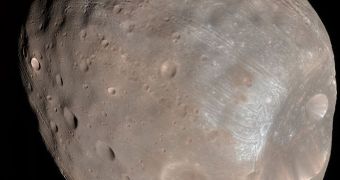The European Space Agency (ESA) announces that its Martian orbiter was recently able to compile a vast set of data about Phobos, one of the two moons revolving around the Red Planet. The achievement is significant, especially given how little scientists actually know about this space object.
For starters, it's not even clear yet whether the space rock was formed from debris ejected from the Martian surface, or whether it coalesced from the same protoplanetary disk that the planet itself did.
A third option would be that both Phobos and Deimos (the other Martian moon) are small asteroids that were caught in orbit around the Red Planet, unable to escape its gravitational pull. Given these uncertainties, the two objects are prime targets for scientific exploration.
ESA recently manage to get a better look at Phobos by using its Mars Express orbiter, which has been in orbit around the planet since December 2003. The spacecraft is younger than the NASA Mars Odyssey, but older than the Mars Reconnaissance Orbiter (MRO).
One of the most interesting aspects about the diminutive Martian moon – which has a radius of only 7 miles (11 kilometers) – is that it moves around the planet faster than Mars itself rotates. Astronomers refer to this as the moon orbiting below the synchronous orbit radius.
During the latest Phobos flyby – which Mars Express carried out on January 9, 2011 – experts got a chance to get within 100 kilometers (60 miles) of the moon's surface. ESA scientists saw the locations were the Russian Federal Space Agency (RosCosmos) wants to land its Phobos-Grunt mission.
Interestingly, the new data the ESA orbiter collected indicate that it's highly unlikely Phobos is a captured asteroid. Mars Express' Planetary Fourier Spectrometer (PFS) instrument reveals that the rocks on the moon have none of the known meteorite signatures that were uncovered on Earth.
Implicitly, these evidence lend additional credence to the theory suggesting that the small moon was formed from debris ejected into Martian orbit when a large impactor – most likely an asteroid or a comet – struck the planet's surface.
“We detected for the first time a type of mineral called phyllosilicates on the surface of Phobos, particularly in the areas northeast of Stickney, its largest impact crater,” explains Dr. Marco Giuranna, quoted by Daily Galaxy.
“This is very intriguing as it implies the interaction of silicate materials with liquid water on the parent body prior to incorporation into Phobos,” adds the expert, who was a coauthor of the new investigation.
“Alternatively, phyllosilicates may have formed in situ, but this would mean that Phobos required sufficient internal heating to enable liquid water to remain stable,” says Dr. Giuranna, who is based at the Italian National Institute for Astrophysics, in Rome.

 14 DAY TRIAL //
14 DAY TRIAL //